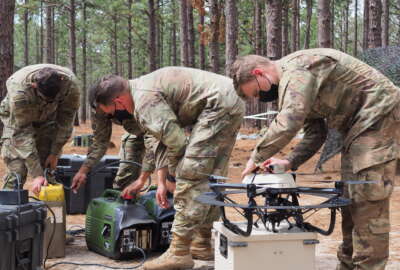
This Energy Department program says cars will run more efficiently without the person behind the wheel
A new funding program from the Advanced Research Projects Agency Energy aims to reduce fuel consumption by conventional cars by automating much of what drivers do.
Best listening experience is on Chrome, Firefox or Safari. Subscribe to Federal Drive’s daily audio interviews on Apple Podcasts or PodcastOne.
A new funding program from the Advanced Research Projects Agency Energy aims to reduce fuel consumption by conventional cars by automating much of what drivers do. Four academic teams have received $18 million on the NextCar program. With more, ARPA-E program director Dr. Marina Sofos, joined Federal Drive with Tom Temin.
Interview transcript:
Tom Temin: Dr. Sofos, good to have you on.
Dr. Marina Sofos: Nice to be on.
Tom Temin: Tell us about this program. This is a multi stage, I guess, competition type of round and you are in round two. Tell us about the program and where it stands at this point.
Dr. Marina Sofos: Yes. So the original NextCar program, which was founded in 2016, was focused on the premise of how could we leverage fencing along with the automated features of driver assistance systems and communications available through conductivity onboard our high end vehicles today? How can we use these types of features and leverage them to optimize the vehicle dynamics? This is things like acceleration, braking, and steering, along with power train control for energy efficiency purposes. So the premise of phase one was can we utilize these types of features that we have on on vehicles today and gain additional energy savings with a goal of 20% in savings, we looked at three types of vehicles, passenger light duty cars, buses, and trucks. And now we’re running a second round, as you mentioned, or next car where we’re focusing in on the light duty passenger vehicles. And over the next three years, a subset of teams will be specifically looking at the next level of connectivity and automation coming down the pike. So it’s more looking into the future. And specifically, how could we leverage higher levels of fencing in productivity that are being explored. These are the potential self driving features that only rely on optional human override and utilize them to go up to 30% savings.
Tom Temin: It sounds like the theory is that with all of these automated controls, that cars are capable of running some cars, then you could eliminate the heavy lead foot and slamming on the brakes a lot boiled down to the essentials.
Dr. Marina Sofos: Yes, exactly. We already know that the human can introduce a lot of variability to the overall energy consumption based on driver habits. And in addition to using these types of automated features, how can we also leverage the vast amount of information that we’re getting about the surrounding environment, not just the vehicle itself, but other vehicles near road conditions and use those as well kind of thinking about preview and look ahead, information further out, such that our vehicle can adjust its driving accordingly.
Tom Temin: So you have four academic institutions examining ways to take all the fun out of driving, essentially? And who are they and what will they be doing over the next few years with this money?
Dr. Marina Sofos: Right. So we have three of the 14 are universities, which include Michigan Tech University, University of California, Berkeley, and the Ohio State University. The fourth is being led by the nonprofit Southwest Research Institute. And each of these teams are partnered with automotive companies as well, including tier one suppliers and OEMs. And so each of them are going to be porting over the technologies they developed in phase one, algorithms that optimize vehicle maneuvers based on the features that we described, and evaluating them with higher levels of automation on prototype vehicles, and also looking for new ways to test and get additional energy savings.
Tom Temin: So in other words, these cars have certain capabilities they can do now you can buy. But what these teams are looking at with your funding is to try to augment those capabilities with new software and new algorithms that a good way to describe it.
Dr. Marina Sofos: Yes, one of the basis of NextCar is very limited hardware intervention. As I said, in phase one, we focused on the existing features on high end vehicles today. In phase two, we’re looking at the self driving features that are not on vehicles that you can purchase today, but on the ones that OEMs are developing, have under development for the future,
Tom Temin: And will one of the four teams come up with an ultimate answer that you will choose in some manner?
Dr. Marina Sofos: Well, all four teams are looking at a variety of maneuvers. And what we learned from phase one and hope to learn from phase two as well are what are the different types of maneuvers that can help contribute to a 30% savings both individually and in combination with other maneuvers and what types of savings are available across A variety of vehicles. So we just took a vehicle agnostic approach in phase one, and we’re taking the same in phase two, our teams are testing a variety of gas powered hybrid electric and electric vehicles. So we’re really wanting to explore the space in a way that can provide the type of information that the automotive industry could use in the in the future to drive additional savings. This is a sector where every percentage point counts in efficiency. And phase one was very successful in showing that we could get up to 20% going beyond the existing strategies that we have in our arsenal, themes, hybridization, electrification, and light-weighting. So we’re adding an additional vector here, and the type of information about these various maneuvers that the OEMs could explore in the future.
Tom Temin: Yeah, you’ve answered my next question. This is not just gasoline cars, but electric cars, I guess even the left to be recharged and don’t use gas, you can get a lot more out of a battery charge if you control them better than if you just stomp on them like a jackrabbit.
Dr. Marina Sofos: Exactly. You can extend your range, which is great. And it also provides additional information to the driver to reduce their anxiety by knowing that if they take one particular route over the other, they could drive additional savings and get additional range. And knowing how much that range actually is is tremendously valuable.
Tom Temin: And what happens to the intellectual property that comes out of these these research programs? Is it proprietary with the manufacturers a given academic team is working with? Is it open source or is it some combination?
Dr. Marina Sofos: It’s really a combination, depending on what is being developed by the team and their existing and future partnerships. But beyond what’s developed in a proprietary nature. The really important thing to note here is it opens up the space for whether it’s innovators and engineers in academic institutions, along with OEMs to develop algorithms with this type of a focus and goal in mind that is improving the efficiency of the vehicle through the information that’s being obtained by conductivity and automation.
Tom Temin: Sure, so you’re almost setting a baseline technology and then the industry will be free to develop it on its own ways beyond that, but at least we’ll get to more efficient vehicles across the board. Sounds like yeah, Dr. Marina Sophos is director of the next car program at the Advanced Research Projects Agency energy. Great to have you on.
Dr. Marina Sofos: Thank you. Great to be on.
Tom Temin: By the way, are you gas electric or hybrid?
Dr. Marina Sofos: So I currently have a gas powered vehicle, but I’m counting down to purchasing an electric vehicle.
Tom Temin: Alright, well stated.
Copyright © 2025 Federal News Network. All rights reserved. This website is not intended for users located within the European Economic Area.
Tom Temin is host of the Federal Drive and has been providing insight on federal technology and management issues for more than 30 years.
Follow @tteminWFED
Related Stories





